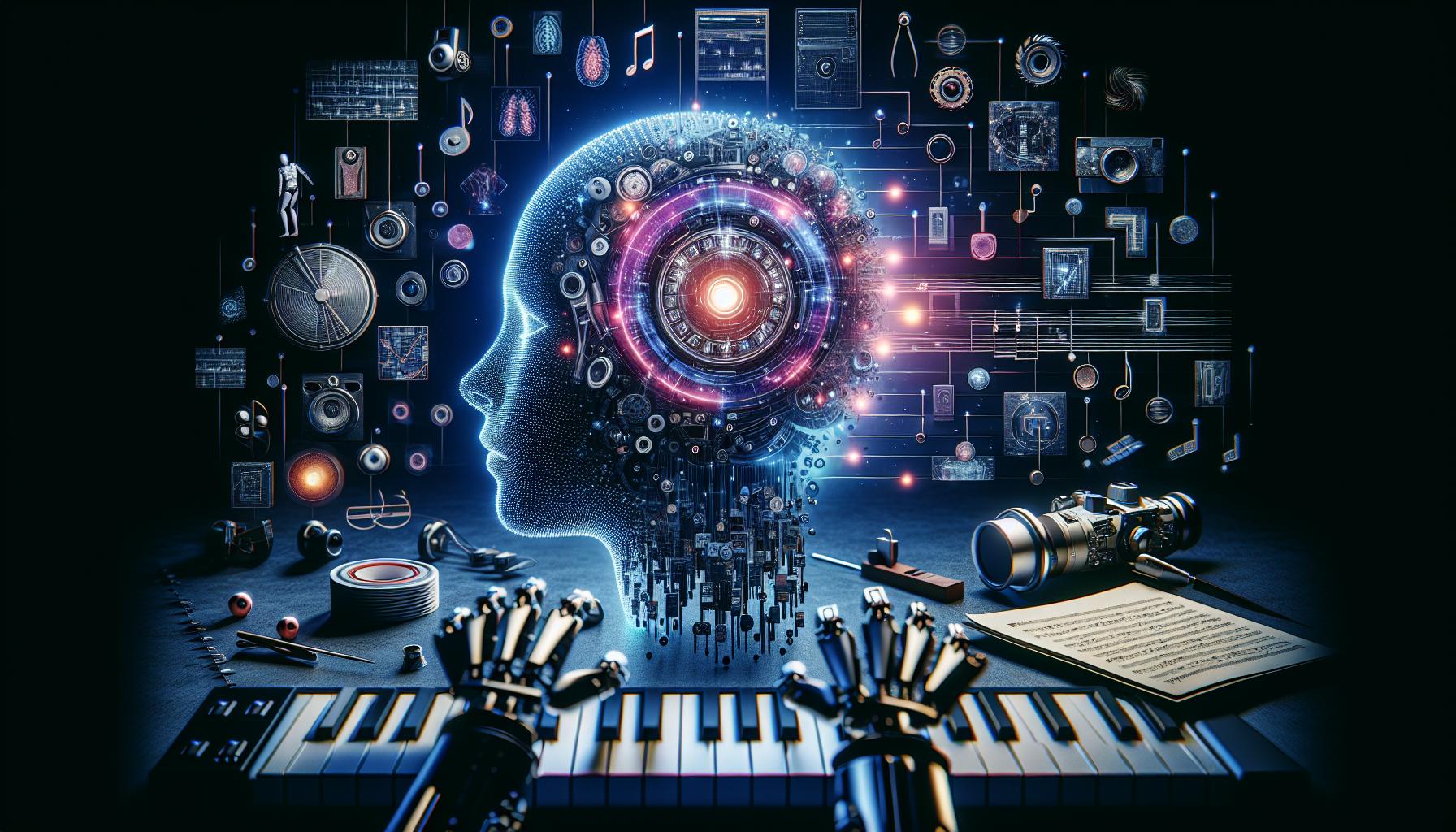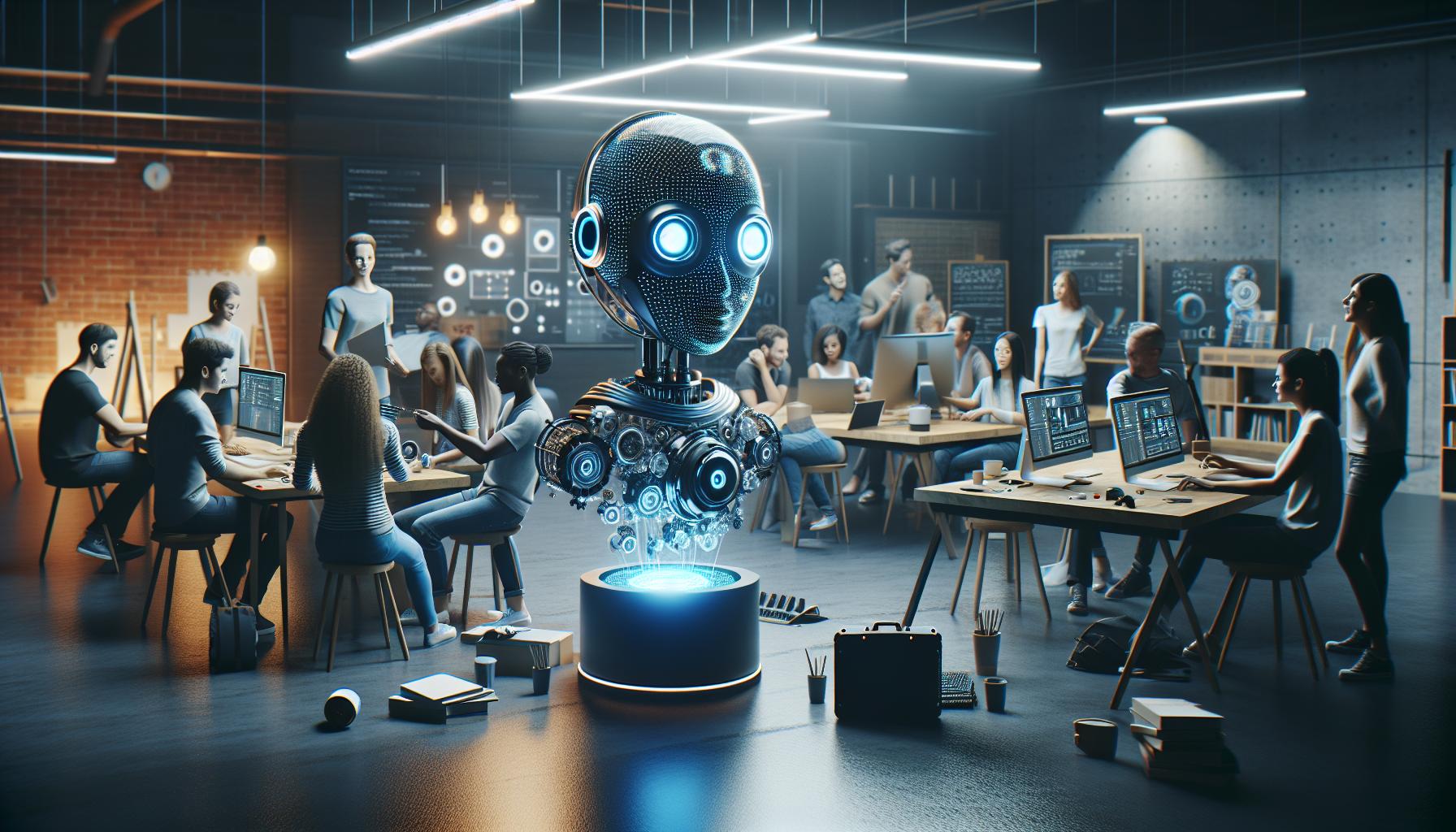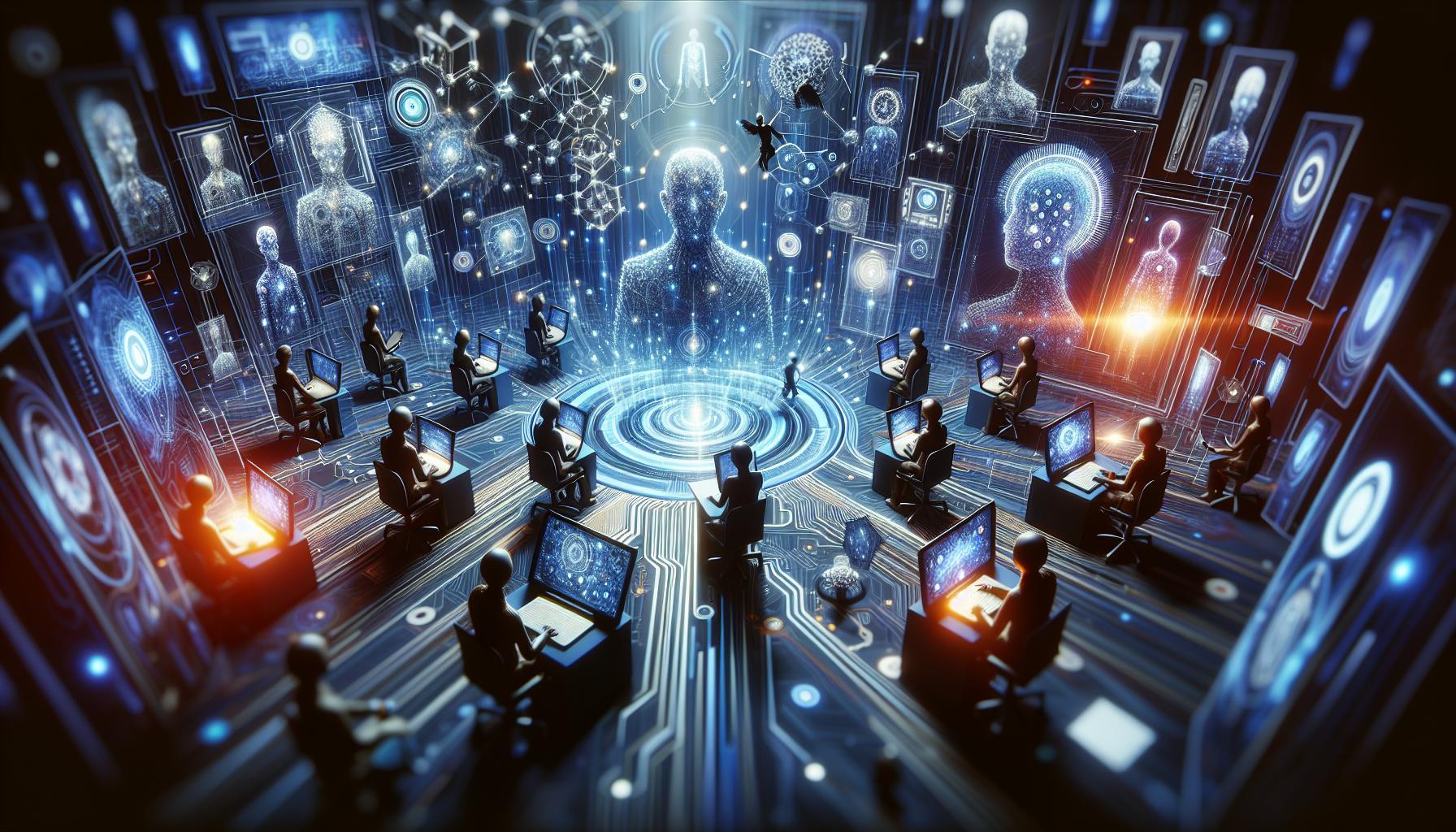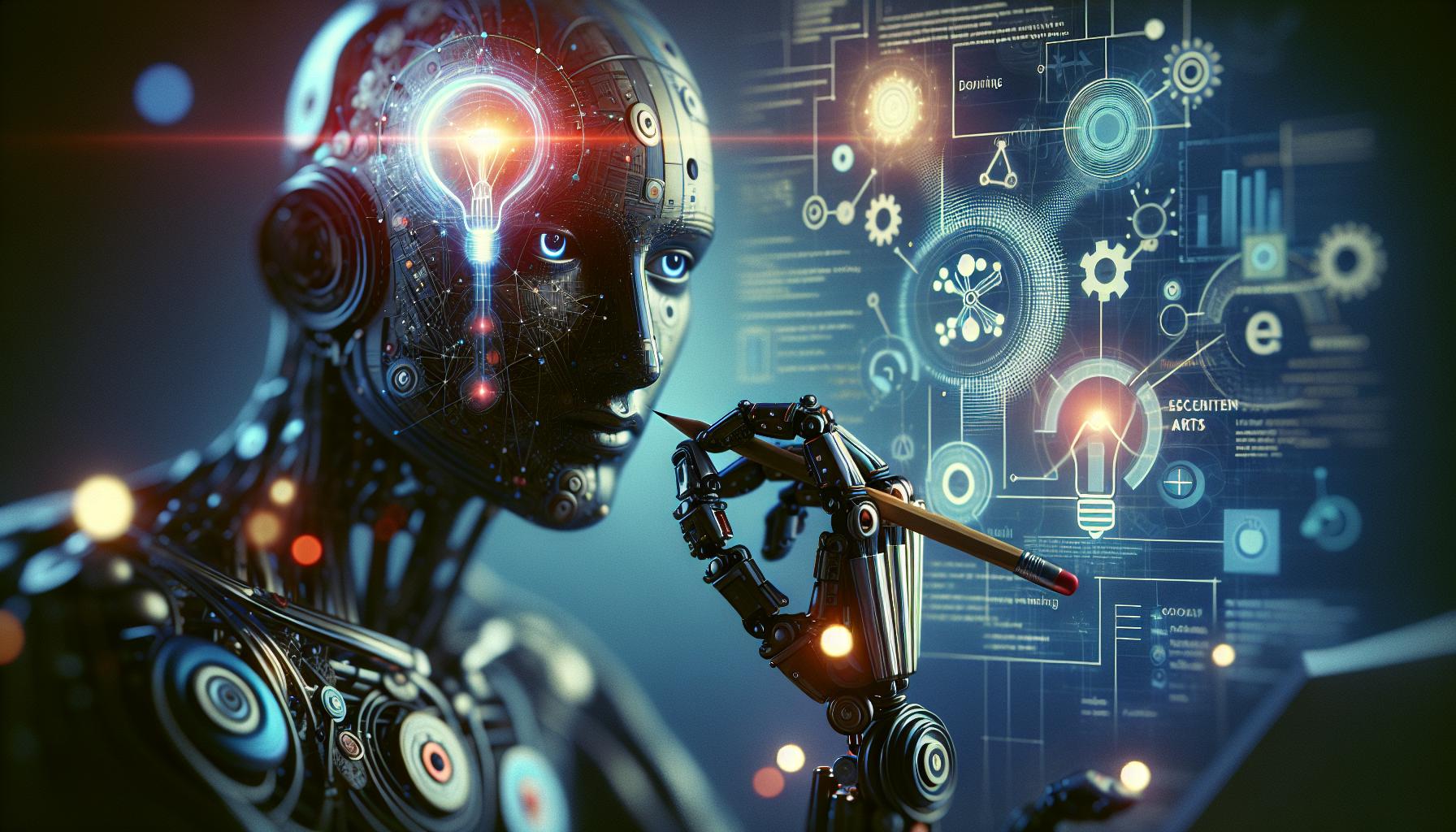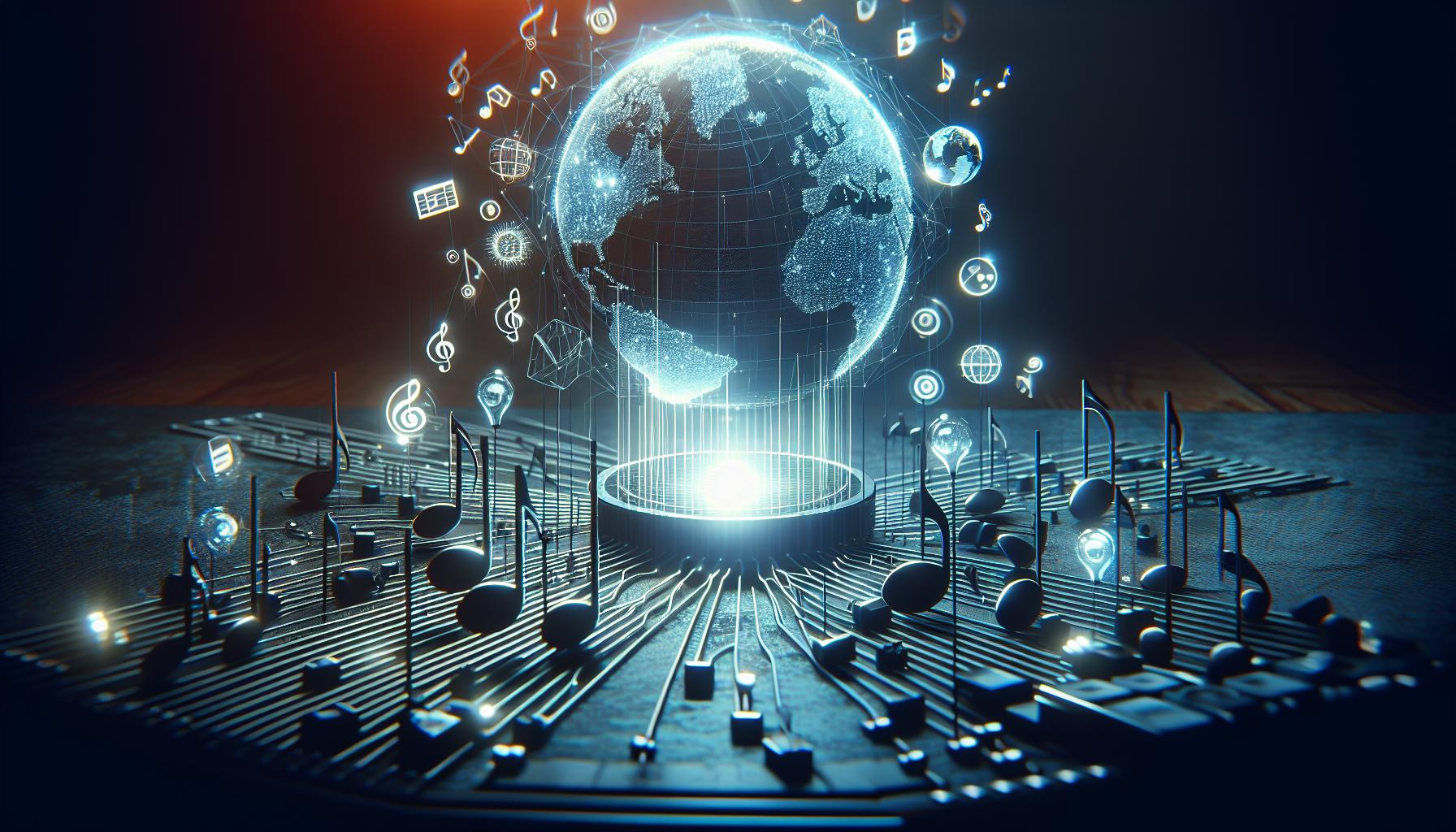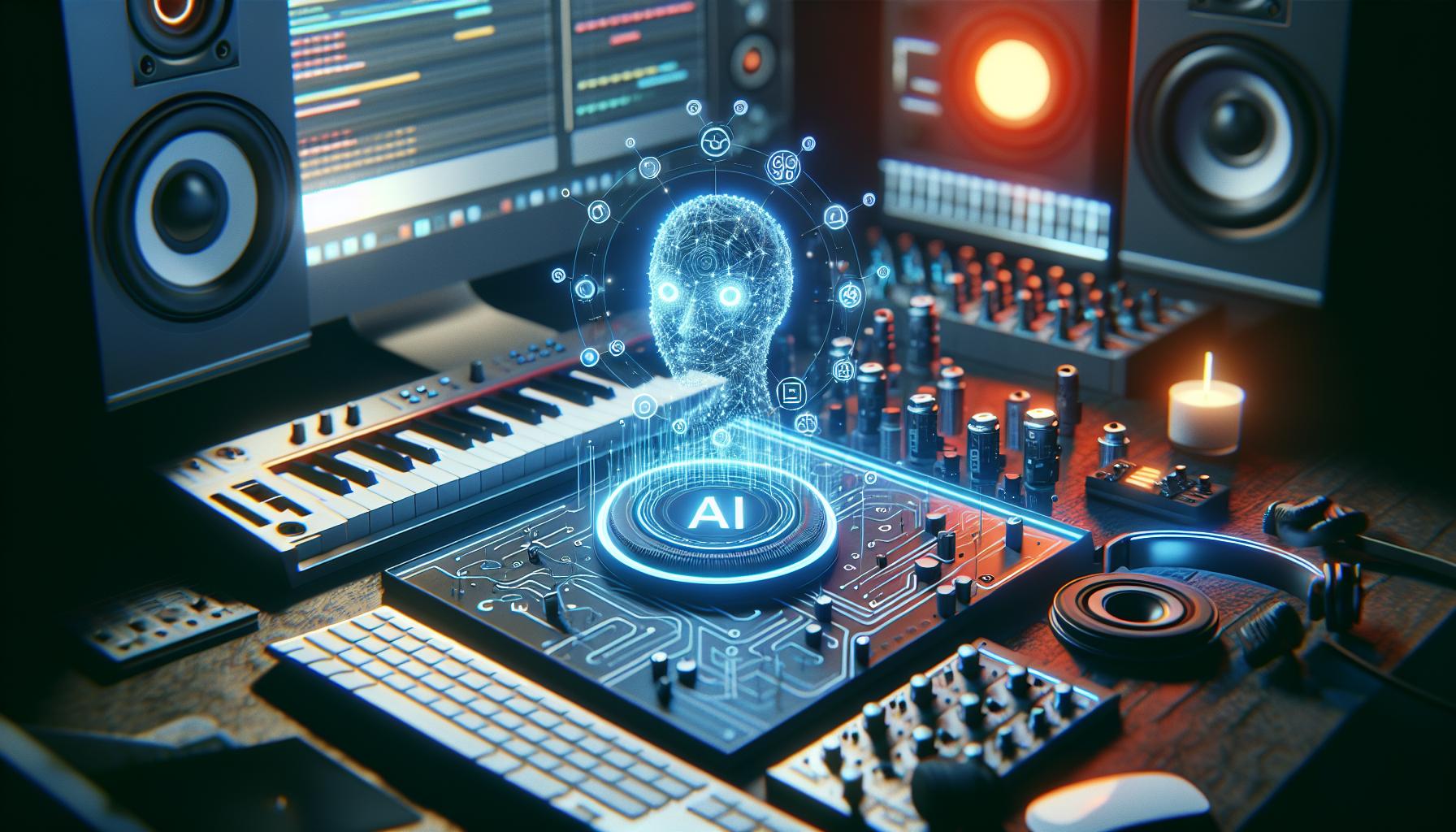In a world where music is ever-evolving, how can artists ensure their tracks stand out from teh crowd? Leveraging AI tools to enhance compositions offers a transformative approach, infusing depth and creativity into your music. This exploration into AI-assisted songwriting reveals how technology can elevate your artistry and captivate audiences like never before.
Understanding AI’s Role in Music Production: A New Frontier
Did you know that AI technology is reshaping the landscape of music production, offering creative solutions that were once unimaginable? As artists and producers navigate the complexities of sound engineering, AI emerges as a powerful ally. It not onyl enhances conventional production methods but also opens new pathways for creativity and innovation.
The Evolution of Music Production with AI
The integration of artificial intelligence into music production marks a revolutionary shift in how music is created and experienced. Traditionally, producing a track required extensive knowledge of equipment, software, and music theory. Now, AI assists in several critical areas:
- Composition: AI algorithms can analyze existing music data to generate original melodies and harmonies, helping artists overcome writer’s block.
- Mixing and Mastering: automated tools can adjust levels, EQ, and effects, streamlining the technical aspects of producing a polished track.
- Sound Design: AI can create unique sounds and effects that may not have been conceived by human designers, adding an innovative touch to productions.
Enhancing Creativity and Depth in Music tracks
With tools designed to assist in extending songs and adding new textures, musicians can explore depths thay never thought possible. As an example, AI-generated accompaniments can fill out a track’s soundscape, transforming a simple melody into a rich arrangement. This technological synergy allows producers to experiment and iterate quickly, enhancing their creative process.
| AI Tool | Functionality | real-World Submission |
|---|---|---|
| Amper Music | AI-driven composition | Generating background scores for video content. |
| Landr | Automated mastering | Streamlining the mastering process for independent artists. |
| AIVA | Emotion-based compositions | Creating soundtracks for films by interpreting emotional cues. |
Harnessing the potential of AI enables musicians to elevate their projects while still retaining their unique sound and style. By using these advanced tools, artists can extend songs with AI, adding layers that engage listeners and provide depth, ultimately resulting in richer musical experiences. Whether facing creative blocks or technical challenges, AI is proving to be an indispensable resource in the pursuit of musical mastery.
Exploring AI Tools for Enhancing Song Composition
Unlocking new Creative horizons
The intersection of technology and music has never been more vibrant, as innovative AI tools emerge to enhance song composition.By leveraging artificial intelligence, musicians can now extend their songs in ways previously thought impractical.These tools analyze vast amounts of musical data, enabling creators to identify trends, harmonies, and structures that resonate with audiences. imagine having a virtual collaborator that not only suggests chord progressions but also helps develop entire verses or bridges, enriching the overall composition and ensuring that every note serves a purpose.
AI-Powered Composition Tools
Utilizing AI for song composition can streamline the creative process,offering insights and enhancements that accelerate productivity. Here are some notable AI tools that can add depth and creativity to your music tracks:
- AIVA: This AI composer creates original music scores in various genres, making it easier to generate unique backgrounds and melodies for your tracks.
- Amper Music: With a few simple inputs, you can craft an entire piece of music tailored to your specifications, allowing for swift adjustments and experimentation.
- IBM Watson Beat: This tool understands emotional intent in music creation, helping artists compose songs that evoke specific feelings and atmospheres.
By incorporating these tools, musicians can not only extend their songs but also explore new sounds and styles previously outside their comfort zones.
Practical Applications of AI in Music Creation
When integrating AI into your songwriting process, consider practical applications that can enhance your creativity. Here’s how to effectively utilize AI tools:
| Step | Action | Expected Outcome |
|---|---|---|
| 1 | Choose an AI music tool suited to your style. | A seamless integration into your workflow. |
| 2 | Input melodies, lyrics, or ideas into the AI interface. | AI-generated suggestions for chord progressions or lyrics. |
| 3 | Refine AI suggestions to align with your artistic vision. | A polished piece that maintains your unique musical identity. |
| 4 | Collaborate with the AI to explore additional variations. | A richer, more diverse composition. |
As you embark on your journey to extend songs with AI, embrace experimentation. These tools are not meant to replace human creativity but to amplify it, allowing you to explore and innovate without boundaries. Whether you’re a seasoned musician or a budding artist, integrating AI into your songwriting process will undoubtedly add depth and creativity to your music tracks.
The Impact of AI on Song Structure and Arrangement
The integration of artificial intelligence into music production is revolutionizing how songs are structured and arranged. With AI tools at their disposal, musicians can now transcend traditional boundaries, inventing new pathways for creativity and expression. This evolution allows artists to experiment with song formats that were previously time-consuming or technically challenging to achieve.
Redefining Song Composition
AI-driven platforms are changing the landscape of songwriting by automating and augmenting various aspects of compositional activity. For example:
- Melody Generation: AI can analyze vast databases of existing songs to suggest harmonic progressions and melodies that fit a given mood or genre.
- Lyric Assistance: Some AI tools can definitely help in crafting lyrics that resonate with listeners, drawing from emotional and thematic analyses.
- Rhythm Enhancements: By predicting trends in acoustic patterns, AI can suggest unique drum beats or rhythm changes that elevate overall arrangements.
These capabilities not only streamline the creative process but also facilitate richer song arrangements, pushing the envelope for what defines a triumphant track.
Dynamic Arrangement Techniques
AI excels in providing musicians with insights into their work, enabling innovative arrangement techniques that complement traditional structures. For example, one popular AI tool can analyze a song’s elements and suggest choice arrangements that could enhance its impact. By examining tempo shifts, transitions, and layering of sounds, AI offers suggestions that might not be immediately apparent to the composer.
| Arrangement Element | AI Feature | Musical Benefit |
|---|---|---|
| Verse/Chorus Structure | Pattern Recognition | Creates engaging listener patterns |
| Bridge Creation | Emotion Analysis | Enhances emotional depth in transitions |
| Layering | Sound Complexity Suggestions | Adds richness and texture to tracks |
Musicians using AI-driven suggestions find the power to experiment with song structures that capture complex emotions and artistic narratives, ultimately leading to more compelling compositions. By allowing AI to act as a creative partner, songwriters can explore uncharted territories of musical arrangement, making the process of extending songs not only innovative but also deeply satisfying.
By embracing these technological advancements, artists can contribute to a vibrant, evolving musical landscape where creativity reigns. The synergy of AI and human emotion opens up endless possibilities, transforming how songs are composed, arranged, and experienced.
Adding Layers: How AI Generates Musical Texture and Depth
Did you know that manny pop hits today incorporate artificial intelligence to create a richer auditory experience? As music production evolves, AI has become an unparalleled ally for musicians looking to expand their sonic palettes. By utilizing machine learning algorithms, artists can enhance their tracks, weaving intricate musical textures that captivate listeners.
Understanding musical Texture
Musical texture refers to how different sounds and layers interact in a piece of music.It’s the intricacy of the harmonies we hear, impacting how a song feels emotionally. When extending a song with AI, consider adding musical layers like:
- Harmonies: AI can suggest complementary chords that fit the song’s key, enriching the harmonic structure.
- Backing Vocals: digital voices can simulate background harmonies, providing depth and warmth.
- Instrumentation: from strings to synths,AI tools can recommend or even create new instrument parts that blend perfectly.
By strategically layering these components,you can transform a simple melody into a lush soundscape that evokes deeper emotional reactions from your audience.
Real-World Applications
Many contemporary artists are already leveraging AI tools to enhance their tracks.As an example, a popular producer recently utilized AI algorithms to generate variations of a drumbeat, leading to a more dynamic rhythm section. this process not only saved time but also opened doors for unexpected creativity.
You can take similar steps by using platforms like Amper Music or AIVA, wich offer intuitive interfaces for creating complex arrangements. These tools allow you to mix and match different musical elements effortlessly.Here’s a practical approach to get started:
Steps to Extend Your Song Using AI
- Choose an AI Tool: Select a platform that suits your needs.
- Upload Your Basic Track: Start with a simple melody or beat that you want to extend.
- Experiment with Suggestions: let the AI analyze your track and propose harmonies or instrumentation.
- Refine and Adjust: Tailor the output to fit your vision by adjusting the tempo, key, or instrument types.
- Export and Polish: once satisfied, export your enhanced track for final tweaks in your DAW.
Incorporating AI into your music production workflow can lead to innovative results and push your creative boundaries. The possibilities of extending your songs with AI are limitless, providing you with both depth and originality that stands out in a competitive music landscape.
Embracing Creativity: Collaborating with AI in the Studio
Did you know that music creation has entered an exciting new era where artificial intelligence not only assists but also enhances the creative process? Musicians and producers increasingly find themselves collaborating with AI to explore new sonic landscapes, pushing the boundaries of what’s possible in the studio. By embracing this technology, artists can confidently extend their songs, add depth, and weave intricate layers into their compositions.
The Dynamic Duo: Musicians and AI
As artists continue to navigate the complexities of modern sound production, AI tools have emerged as valuable collaborators. these innovative systems can analyze trends, suggest chord progressions, and even generate unique melodic lines tailored to the artist’s style. This partnership allows artists to focus on their vision while leveraging AI’s computational strengths. Here are some compelling ways to integrate AI into your music-making process:
- Idea Generation: Use AI-driven platforms to develop musical ideas or themes, starting a creative spark even before hitting the studio.
- Sound Design: Experiment with AI tools that generate sounds or textures, adding distinctive elements that might not have been conceived otherwise.
- Feedback and Revision: Employ AI to assess mixes or arrangements, providing constructive suggestions based on a plethora of analyzed tracks.
- Collaborative Writing: Co-write lyrics or melodies with AI, creating unexpected combinations that enhance the emotional richness of your songs.
real-World Examples of AI in Action
Many renowned artists and producers are already successfully utilizing AI in their creative processes. As a notable example,electronic musician Holly Herndon employs a vocal synthesis tool called Spawn,designed to extend her songwriting palette. Similarly,producers like Taryn Southern have turned to AI algorithms to generate melodic sequences and harmonies,ultimately adding layers of sophistication to their tracks. These innovative approaches showcase AI’s ability to harmonize creativity with technology, making it an invaluable asset for the modern artist.
Practical Steps to Incorporate AI
To genuinely benefit from AI’s contribution in your studio, consider these practical steps:
| Step | Description |
|---|---|
| 1. Explore AI Tools | Identify AI software or platforms that match your artistic needs, from composition aids to mixing enhancers. |
| 2. Start Small | Incorporate AI into small sections of your work to gauge its impact without overwhelming your creative flow. |
| 3. Collaborate and Share | Engage with other artists who are using AI, sharing insights and experiences to maximize your creative potential. |
| 4. Iterate and Evolve | Use feedback—both from the AI and fellow musicians—to refine your compositions, ensuring they align with your artistic vision. |
By integrating AI into your studio practices, you can efficiently extend your songs while adding unparalleled depth and creativity. This collaboration not only enhances your work but also pushes you to explore new artistic horizons that were previously unimaginable.
Ethical Considerations in AI-Enhanced Music Creation
In the rapidly evolving landscape of music creation, the integration of AI technologies has invited not only excitement but also a host of ethical considerations. As artists leverage AI to extend songs and infuse new layers of creativity,it becomes vital to navigate the moral implications of these advancements. The convergence of technology and artistry raises essential questions regarding authorship, originality, and the sustainability of the creative process.
Intellectual Property and Authorship
One of the foremost ethical dilemmas in AI-enhanced music creation revolves around intellectual property. When an AI algorithm contributes to the composition of a song, who holds the copyright? Is it the artist who initiated the process, the developer of the AI software, or the machine itself? This ambiguity can create friction within the music industry. For instance, a well-known case involved a music piece generated by AI that was claimed by the AI’s creators, leading to debates over whether AI-generated content should be eligible for copyright protection. It’s crucial for artists to clarify ownership issues through licensing and contractual agreements with AI service providers.
Authenticity and Originality
As musicians use AI tools to enhance their tracks,concerns about the authenticity and originality of their work arise. There is a fine line between utilizing AI to inspire creativity and relying on it so heavily that the final product lacks personal touch. While AI can definitely help extend a song by generating unique musical elements, artists should strive to ensure that their voice remains central to the music. To maintain originality, consider implementing the following practices:
- Blend Human and Machine: Use AI-generated suggestions as a starting point, allowing your creativity to shape the final outcome.
- Customize AI Outputs: Rather of taking AI suggestions at face value, modify them to align with your artistic vision.
- Transparency: Be open about your use of AI in your music, which can enhance the authenticity of both the process and the product.
Impact on Musicians and the Industry
The rise of AI-enhanced music creation may also impact job dynamics within the industry. Many fear that widespread adoption of AI tools could lead to job displacement for session musicians, songwriters, and producers. Though, this technology can also serve as a powerful collaboration tool, allowing creators to focus on high-level artistic decisions while automating repetitive tasks. For example, AI can assist in generating backing tracks or assisting in sound design, freeing up artists to dedicate more time to songwriting and performance.
Ultimately, as you embark on your journey to extend songs with AI and deepen the creativity of your music tracks, consider the ethical landscape in which you operate. Embrace technology as a companion in your artistic endeavors, while remaining cognizant of the implications your choices may hold for the industry and your individual artistic integrity. Balancing these considerations will not only enrich your music but also contribute to a more sustainable future for the art form as a whole.
Case studies: Successful Artists Leveraging AI in Their Work
Innovative Use of AI by Industry Pioneers
In the rapidly evolving landscape of music production, several artists are using AI to not only enhance their sound but also to revolutionize their creative processes. For example, a recent project by The Beatles showcased AI’s powerful capabilities when they utilized the technology to isolate John Lennon’s voice from a 1978 demo. this innovative approach allowed the band to revisit and reinterpret their past work, breathing new life into classic tracks while providing fans with unique listening experiences. By leveraging AI to extend their songs, they exemplified how artists can push the boundaries of music creation, merging tradition with cutting-edge technology [[3]].
another artist making waves is the rising electronic musician Grimes, who has openly discussed her integration of AI in both songwriting and music production. By using machine learning algorithms to generate melodies and harmonies, Grimes expands her creative possibilities, allowing for a blend of human emotion and machine precision. This technique not only streamlines her workflow but also enables her to explore sounds that she might not have considered or else.As AI continues to improve in understanding music theory and composition, artists like grimes exemplify how leveraging AI can substantially extend their song creation processes while enhancing overall creativity.
Practical Application of AI Tools
Artists seeking to extend their songs with AI should consider the following practical steps:
- Experiment with AI-Assisted Software: Platforms like Amper Music and OpenAI’s MuseNet allow musicians to create original compositions by inputting various prompts, styles, or even blending genres.
- utilize AI for Mixing and Mastering: Tools such as LANDR can automate the mixing process, providing quick and efficient mastering that retains the artist’s original sound while improving audio quality.
- Analyze Audience preferences: Use AI-driven data analytics to understand what types of music resonate with listeners, guiding artists in songwriting and production decisions.
As artists explore these AI applications to extend their songs, they open doors to immense creative potential, enriching their music tracks while maintaining their unique artistic identities. Through the innovative use of AI, the music industry is witnessing a change that blends technological advancement with human creativity, paving the way for the future of music production.
The Future of Music: Balancing Innovation with Tradition
The music industry stands at a thrilling crossroads where technology meets artistry, challenging traditional norms while paving the way for innovative soundscapes. With advances like AI tools designed to extend song capabilities, artists can explore uncharted territories of creativity, enriching their tracks with unparalleled depth. These innovations raise the question: how can musicians harmonize technological advancements with the rich traditions of music-making?
Innovative Tools in the Music Ecosystem
As musicians leverage AI to enhance their creative processes, several platforms are emerging that allow for the extension of songs beyond their original compositions.By utilizing AI-driven tools,artists can manipulate sound and introduce novel elements that complement their unique style. Consider the following:
- AI composition Assistants: Software that can suggest melodies or harmonies based on existing tracks, allowing artists to build upon traditional motifs with modern flair.
- Automated Mastering Services: Tools that enhance sound quality while preserving the authenticity of the original recordings,making high-quality music accessible to all.
- Virtual Collaborations: Platforms that facilitate remote collaboration, making it easier for artists worldwide to blend diverse genres and techniques.
Integrating these tools can amplify the creativity of artists while still respecting the foundational principles that make music universally appealing.
Preserving Tradition Amidst Change
While AI empowers a new wave of musical expression, it is crucial to remember the cultural significance embedded in traditional music. Iconic genres that have shaped our collective musical experience should not be overshadowed by technological advances. Musicians can ‘extend songs’ by invoking traditional instrumentation or structures while infusing AI-generated elements to breathe new life into timeless sounds.This approach allows artists to retain the essential qualities of their music while embracing innovation.
Practical steps for Artists
To effectively balance innovation with tradition,musicians should consider the following actionable strategies when using AI to extend their songs:
| Step | Description |
|---|---|
| Identify Your Core Sound | Recognize the traditional aspects of your music that resonate with your audience. |
| Research AI Tools | Explore different AI platforms that can enhance your music while aligning with your artistic vision. |
| Experiment and Iterate | Test various AI-generated ideas and assess how well they integrate with your traditional style. |
| Gather Feedback | Share your extended tracks with peers or through social media to gain insights and refine your approach. |
these steps can aid artists in harnessing the power of technology while maintaining a deep connection to their musical heritage. In this ever-evolving landscape, the future of music will likely be defined by those who can skillfully navigate the space between innovation and tradition, creating experiences that resonate across generations.
Practical Tips for Integrating AI into Your Music Workflow
Did you know that integrating AI in music production can significantly enhance your creativity and workflow efficiency? as technology continues to advance, tools that allow creatives to extend their songs with AI are becoming more elegant, enabling musicians to explore new sonic landscapes and refine their sound like never before.Here are some practical tips to seamlessly incorporate AI into your music workflow.
Embrace Creative AI Tools
The first step in enhancing your music tracks is exploring the variety of creative AI tools available. Consider using AI-based software that analyzes your existing tracks and suggests chord progressions or harmonizations. applications like *Landr* for mastering and *Amper Music* for generating unique compositions can be game changers. These tools not only save time but also offer fresh perspectives that you might not have considered.
Utilize AI for Sound Design
Sound design is a critical element in music production, and AI can assist in generating new sounds or modifying existing ones. Using platforms like *AIVA* or *OpenAI’s Jukedeck*, you can create custom samples that add a unique flavor to your projects. Here’s how to effectively use AI for sound design:
- Experiment with Different Parameters: Many AI tools allow you to manipulate various elements such as tempo, mood, or instrumentation. Spend time experimenting to see what works best for your track.
- Iterate on Suggestions: Don’t just accept the AI output as final. Use it as a starting point and iterate upon it—layer sounds, adjust effects, and blend them with your own compositions.
- Combine AI with Traditional Techniques: Always use AI tools in conjunction with your understanding of music theory and composition. This fusion leads to richer and more complex arrangements.
Collaborate with AI
Rather of viewing AI as a replacement for human creativity,think of it as a collaborative partner. Many artists find that pairing their instincts with AI-generated suggestions can lead to unexpected but rewarding results. For example, AI can definitely help create variations of a melody or suggest a bridge that transforms the structure of your song. Here’s a brief approach to collaborating with AI:
| Collaboration Tactics | Description |
|---|---|
| Feedback Tuning | Utilize AI to analyze your track’s emotional impact and get suggestions for refining the arrangement accordingly. |
| Loop and Layering | Generate loops through AI algorithms and layer them creatively with your recorded parts; this adds depth and texture. |
| AI in Live Settings | In live performances, use AI for real-time accompaniment, providing an immersive experience for your audience. |
By incorporating these strategies, you can effectively use AI to extend your songs, adding depth and creativity to your music tracks. The fusion of human creativity with artificial intelligence can lead to a new era of artistic expression, redefining how music is composed and experienced.
Navigating the Challenges of AI in the Creative Process
AI’s integration into music production heralds a new era of creative possibilities,yet it also introduces a set of challenges that artists must confront. Many musicians wonder whether the assistance of AI will stifle their originality or dilute the emotional resonance of their work. As a notable example, while tools that aim to extend songs with AI can generate captivating melodies or harmonies, they may inadvertently lead to a homogenization of sound if not used thoughtfully. It’s crucial for musicians to maintain a balance between leveraging AI for creativity and preserving their unique artistic voice.
One of the primary challenges is the potential dependency on AI-generated content.Musicians can easily fall into the trap of relying solely on technology to enhance their compositions. To counteract this, it’s vital to employ AI as a collaborative partner rather than a crutch. Artists should focus on integrating AI-driven elements into their workflows in a way that enhances rather than replaces their creative instincts. Consider dedicating specific sessions solely for experimentation with AI tools, allowing you to explore new ideas without immediately committing them to a project.
Moreover, navigating the ethical landscape associated with AI in music is essential. Issues surrounding copyright and ownership can become complex when AI systems generate portions of a track.artists should remain informed about the legal ramifications of using AI-generated content. Incorporating clear licensing agreements and understanding the terms of use for the AI tools employed can safeguard musicians from potential disputes over intellectual property.
By treating AI as a valuable ally that can help extend songs and add depth to tracks, musicians can tackle these challenges head-on. Here are some actionable steps they can take:
- Experiment Regularly: Dedicate time each week to explore AI tools without pressure to produce a final product.
- Keep a creative Journal: Document your ideas and the role AI plays in them to maintain a sense of ownership.
- stay Informed: Regularly review advancements in AI technology and their implications for copyright and creativity.
Ultimately,embracing the collaborative potential of AI while remaining vigilant about these challenges can lead to a more enriched and innovative creative process.
The Way Forward
As we conclude our exploration of extending songs with AI,it’s clear that this technology offers a plethora of innovative possibilities for enhancing musical creativity. From algorithmic composition techniques that generate unique melodies to machine learning models that analyze existing tracks for stylistic improvements, AI can indeed add depth to your music.
however, it’s crucial to approach these advancements with a discerning mindset. While the potential for artistic expansion is vast, balancing technological integration with ethical considerations remains essential. Artists must navigate intellectual property concerns and the authenticity of AI-generated content, ensuring that the soul of their music—its emotional resonance—remains intact.
We encourage you to delve deeper into the world of AI-driven music creation.Experiment with different AI tools, explore collaborations with software, and engage with communities that share your passion for music and technology. Whether you’re a seasoned professional or a curious beginner, the intersection of AI and music is ripe with opportunities for discovery and innovation. Embrace the journey, and let your music evolve in ways you never thought possible.



